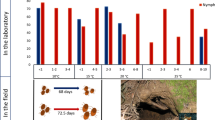Abstract
Contrary to current opinion, fully engorged and detached larvae and nymphs of some ixodid ticks consistently take up substantial amounts of atmospheric water vapour and thereby display their regulative capacity for maintaining water balance in subsaturated air. Net uptake of vapour generally begins some days after detachment and the capability persists until shortly after initiation of apolysis, a period which in diapausing specimens may extend up to several months. This was shown forIxodes ricinus, Haemaphysalis punctata, and the North AmericanI. dammini. Apparently, some other engorged ixodid immatures fail to exhibit net vapour uptake, as was shown for both larvae and nymphs ofDermacentor marginatus and nymphs ofHyalomma anatolicum excavatum. But there is some evidence for engorged nymphs ofD. marginatus that active uptake of vapour does occur, masked by spiracular transpiration. Net uptake of vapour is apparently not possible during the pharate phases. InI. ricinus both teneral nymphs and adults are capable of achieving net water gains by active vapour uptake on the first day following ecdysis. There is new evidence from fully engorgedI. ricinus immatures for the decisive role of agranular alveoli in the production of the salivary secretion involved in vapour uptake.
Similar content being viewed by others
References
Balashov, Yu.S., 1968. Bloodsucking ticks (Ixodoidea)—vectors of diseases of man and animals. Misc. Publ. Entomol. Soc. Am., 8:161–376 (1972 transl.).
Barker, D.M., Ownby, C.L., Krolak, J.M., Claypool, P.L. and Sauer, J.R., 1984. The effects of attachment, feeding, and mating on the morphology of the type I alveolus of salivary glands of the lone star tick,Amblyomma americanum (L.). J. Parasitol., 70:99–113.
Belozerov, V.N., 1964. Dynamics of gas exchange during the development of ixodid ticks. 1. Dynamics of gas exchange in the larval and nymphal stages ofDermacentor marginatus (Sulz.) andIxodes ricinus (L.) (Acarina, Ixodidae). Entomol. Rev., 43:288–292.
Belozerov, V.N. and Galyal'Murad, M., 1977. Photoperiodic regulation of nymphal diapause inHyalomma anatolicum (Acarina, Ixodidae). Entomol. Rev., 56:495–504.
Binnington, K.C., 1978. Sequential changes in salivary gland structure during attachment and feeding of the cattle tick,Boophilus microplus. Int. J. Parasitol., 8:97–115.
Chinery, W.A., 1965. Studies on the various glands of the tickHaemaphysalis spinigera Neumann 1897. Part III. The salivary glands. Acta Trop., 22:321–349.
Harris, R.A. and Kaufman, W.R., 1981. Hormonal control of salivary gland degeneration in the ixodid tickAmblyomma hebraeum. J. Insect Physiol., 27:241–248.
Heath, A.C.G., 1981. The temperature and humidity preferences ofHaemaphysalis longicornis, Ixodes holocyclus andRhipicephalus sanguineus (Ixodidae): Studies on engorged larvae. Int. J. Parasitol., 11:169–175.
Hefnaway, T., 1970. Biochemical and physiological studies of certain ticks (Ixodidae). Water loss from the spiracles ofHyalomma (H.) dromedarii Koch (Ixodidae) andOrnithodoros (O.) savignyi (Audouin) (Argasidae). J. Parasitol., 56:362–366.
Jaworski, D.C., Sauer, J.R., Williams, J.P., McNew, R.W. and Hair, J.A., 1984. Age-related effects on water, lipid, hemoglobin, and critical equilibrium humidity in unfed adult lone star ticks (Acari: Ixodidae). J. Med. Entomol., 21:100–104.
Kahl, O. and Knülle, W., 1986. Water vapour uptake by engorged immature ixodid ticks. In: H. Velthuis (Editor), Proc. 3rd European Congr. Entomology, 24–29 August 1986, Amsterdam. Univ. Press, Utrecht, Part 2, pp. 275–278.
Kaufman, W.R., 1983. The function of tick salivary glands. In: K.F. Harris (Editor), Current Topics in Vector Host Research. Vol. 1, Praeger Scientific, New York, pp. 215–247.
Kaufman, W.R., 1986. Salivary gland degeneration in the female tick,Amblyomma hebraeum Koch (Acari: Ixodidae). In: J.R. Sauer and J.A. Hair (Editors), Morphology, Physiology, and Behavioral Biology of Ticks. Ellis Horwood Ltd., Chichester, pp. 46–54.
Kaufman, W.R. and Sauer, J.R., 1982. Ion and water balance in feeding ticks: mechanisms of tick excretion. In: F.D. Obenchain and R.L. Galun (Editors), Physiology of Ticks. Pergamon Press, Oxford, pp. 213–244.
Knülle, W. and Rudolph, D., 1982. Humidity relationships and water balance of ticks. In: F.D. Obenchain and R.L. Galun (Editors), Physiology of Ticks. Pergamon Press, Oxford, pp. 43–70.
Lees, A.D., 1946. The water balance inIxodes ricinus L. and certain other species of ticks. Parasitology, 37:1–20.
McMullen, H.L., Sauer, J.R. and Burton, R.L., 1976. Possible role in uptake of water vapour by ixodid tick salivary glands. J. Insect Physiol., 22:1281–1285.
Needham, G.R., and Coons, L.B., 1984. Ultrastructural changes in type I alveoli of the salivary glands from hydrating and desiccating lone star ticks. In: D.A. Griffiths and C.E. Bowman (Editors), Acarology 6. Proc. VIth Int. Congr. Acarology, Edinburgh, 1982. Ellis Horwood Ltd., Chichester, Vol. 1, pp. 366–373.
Needham, G.R. and Teel, P.D., 1986. Water balance by ticks between bloodmeals. In: J.R. Sauer and J.A. Hair (Editors), Morphology, Physiology, and Behavioral Biology of Ticks. Ellis Horwood Ltd., Chichester, pp. 100–151.
Norval, R.A.I., 1977. Studies on the ecology of the tickAmblyomma hebraeum Koch in the Eastern Cape Province of South Africa. II. Survival and development. J. Parasitol., 63:740–747.
Rudolph, D., and Knülle, W., 1974. Site and mechanism, of water vapour uptake from the atmosphere in ixodid ticks. Nature (Lond.), 249:84–85.
Rudolph, D. and Knülle, W., 1978. Uptake of water vapour from the air: process, site and mechanism in ticks. In: K. Schmidt-Nielsen, L. Bolis and S.H.P. Maddrell (Editors), Comparative Physiology: Water, Ions and Fluid Mechanics. Cambridge Univ. Press, London, pp. 97–113.
Rudolph, D., and Knülle, W., 1979. Mechanisms contributing to water balance in non-feeding ticks and their ecological implications. In: J.G. Rodriguez (Editor), Recent Advances in Acarology, Vol. 1, Academic Press, New York, pp. 375–383.
Sauer, J.R. and Hair, J.A., 1971. Water balance in the lone star tick (Acarina: Ixodidae): the effects of relative humidity and temperature on weight changes and total water content. J. Med. Entomol., 8:479–485.
Sweatman, G.K., 1967. Physical and biological factors affecting the longevity and oviposition of engorgedRhipicephalus sanguineus female ticks. J. Parasitol., 53:432–445.
Till, W.M., 1961. A contribution to the anatomy and histology of the brown ear tick,Rhipicephalus appendiculatus Neumann. Mem. Entomol. Soc. S. Afr., 6:1–124.
Winston, P.W. and Bates, D.H., 1960. Saturated solutions for the control of humidity in biological research. Ecology, 41:232–237.
Author information
Authors and Affiliations
Rights and permissions
About this article
Cite this article
Kahl, O., Knülle, W. Water vapour uptake from subsaturated atmospheres by engorged immature ixodid ticks. Exp Appl Acarol 4, 73–83 (1988). https://doi.org/10.1007/BF01213843
Accepted:
Issue Date:
DOI: https://doi.org/10.1007/BF01213843




